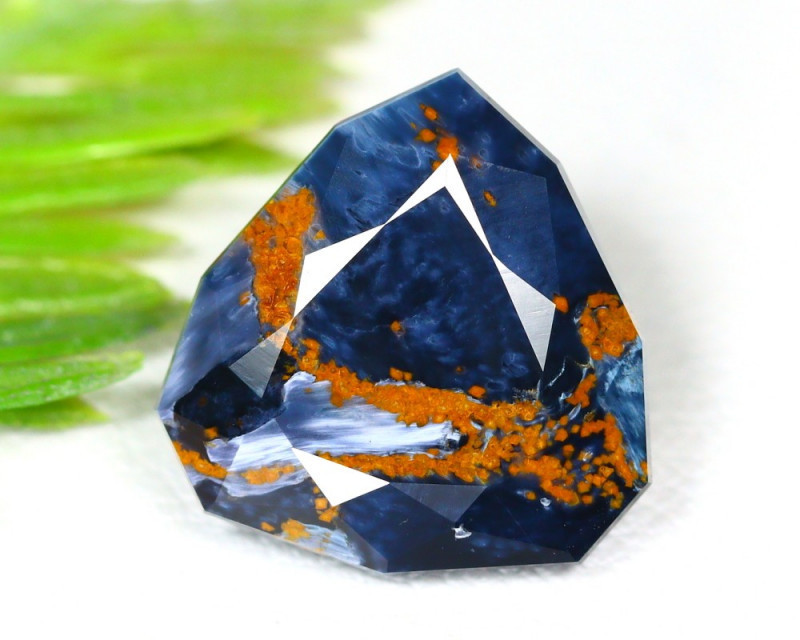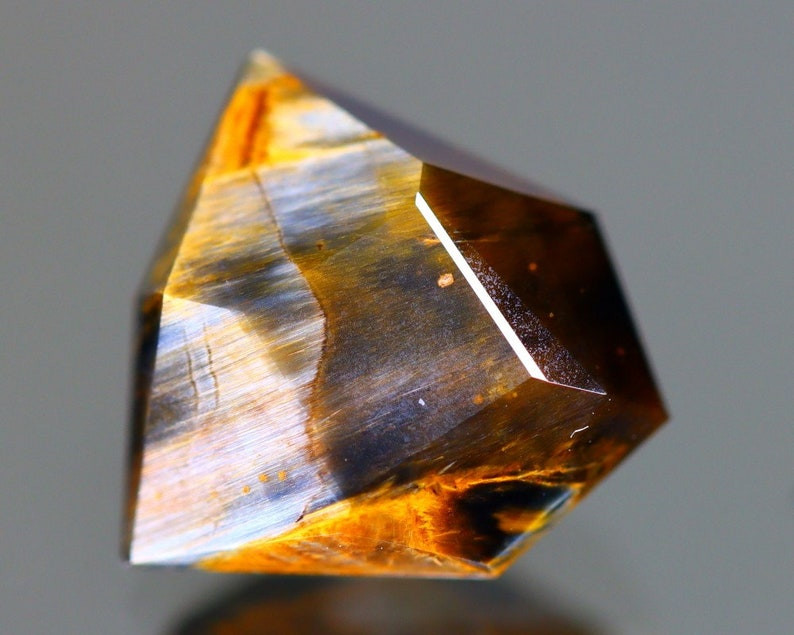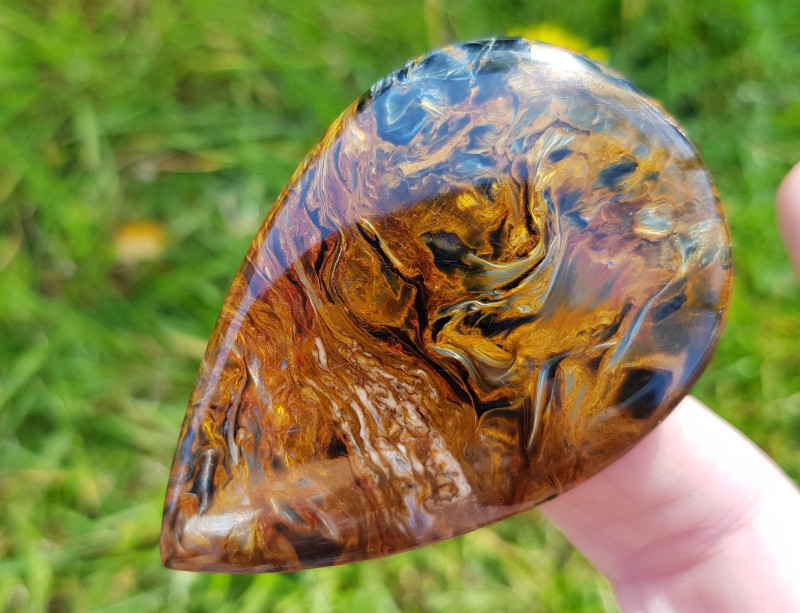
Pietersite Gemstone: Properties, Meanings, Value & More
Pietersite is a predominantly blue, red, and gold patterned chalcedony variety composed of numerous minerals cemented together by quartz. Is pietersite a gemstone, then? Absolutely! But whether it’s a mineral or not is debated.
Is pietersite rare? Yes, pietersite gemstones are rare — only found in a couple of places.
If you’re a fan of tiger’s eye or hawk’s eye gems, you’ll often see pietersite mentioned with these two. That’s because pietersite, also called “eagle’s eye,” uniquely relates to them.
We’ve spent years exploring and selling hundreds of gemstones, including gorgeous chatoyant beauties like pietersite. Today, we’re sharing the knowledge we’ve gained along the way as we teach you about pietersite’s properties, history, value, and uses.
 Pictured above: Pietersite gemstone faceted into modified trillion shape
Pictured above: Pietersite gemstone faceted into modified trillion shape
About Pietersite Stone
Pietersite is a blue- or brown-based semi-precious gemstone known for its unique patterns, often in orange and yellow hues.
Other names for pietersite include:
Touchonite
Tempest Stone
Eagle’s Eye
This unique gem is an alternative August birthstone and a lucky astrological birthstone for Leo.
Pietersite Specifications & Characteristics
Depending on who you ask, pietersite may be called a mineral or a rock. Its similarity to tiger’s eye (a metamorphic rock) supports the rock theory, along with the observation that pietersite seems to be a breccia aggregate — in other words, a stone made up of mineral fragments embedded in a matrix.
But many mineralogists classify pietersite as a variety of the mineral chalcedony, so it’s unclear who is correct.
Pietersite is characterized by internal fibers of amphibole minerals, common rock-forming silicates like sodium, iron, and aluminum.
The embedded fibers give pietersite both stunning coloring and impressive simple chatoyancy, like the “cat’s eye” effect but with multiple lines of reflected light.
The stone is primarily microcrystalline quartz (chalcedony) and a variable amount of crocidolite. Crocidolite, or blue asbestos, is a grayish-blue to green variety of riebeckite, an amphibole mineral.
Wait, asbestos? Considering this fact, is pietersite safe to wear? Pietersite that has already been cut is safe to wear. The risk comes when handling raw pietersite, but we’ll touch on that later.
For now, let’s look at the complete list of pietersite properties:
Mohs hardness: 6.5-7
Color: Almost always multi-colored; Usually predominantly blue or brown, often with golden yellow, white, and/or black too
Crystal structure: Trigonal (chalcedony); Monoclinic (crocidolite)
Luster: Vitreous (glassy); Often silky on fractures
Transparency: Semi-translucent to opaque
Refractive index: 1.544-1.553
Density: 2.50-2.74
Cleavage: None
Fracture: Splintery
Streak: White
Luminescence: Fluorescence sometimes present; White (in portions of calcite inclusions), light green, or bright green in SW-UV & light green in LW-UV
Pleochroism: None
Birefringence: 0.004
Dispersion: None
Many of the differences between chalcedony vs pietersite’s properties come from pietersite’s crocidolite content.
The amount of crocidolite present in pietersite varies — different amounts lead to different ratios of gray-blue and orange-brown, along with unique color-banding patterns. Crocidolite is also a key component of tiger’s eye.
 Pictured above: Tiger's eye (left) and hawk's eye (right)
Pictured above: Tiger's eye (left) and hawk's eye (right)
Pietersite vs Tiger’s Eye & Hawk’s Eye
Tiger’s eye and hawk’s eye are pretty much the same stone, but different amounts of iron lead to their amber-brown and blue colors, respectively. As you know, tiger’s eye and hawk’s eye are often part of pietersite’s structure.
Crocidolite is one of the minerals in tiger’s eye, and it can give both tiger’s eye and pietersite simple chatoyancy. Some gemologists believe pietersite could be an oxidized form of riebeckite (crocidolite’s parent stone) surrounded by quartz.
So, is tiger’s eye a pietersite? Not exactly. Sometimes “pietersite” is used as a trade name for brecciated tiger’s eye, but they’re distinct gems.
What about hawk’s eye? Is blue tiger’s eye pietersite? Again, not exactly. Both tiger’s eye and hawk’s eye (blue tiger’s eye) are often found within pietersite.
The easiest way to differentiate either stone from pietersite is by examining their surfaces. Tiger’s eye and hawk’s eye have fairly uniform coloring and chatoyancy, typically in parallel lines. Pietersite has more chaotic streaks of light and coloring, with lines and swirls in different directions.
 Pictured above: Master cut faceted pietersite gemstone
Pictured above: Master cut faceted pietersite gemstone
Pietersite History
Sid Pieters, a prominent collector and dealer of Namibian minerals, wrote the first description of pietersite in 1962. He’d discovered the stone while prospecting farmland in Outjo, in north-central Namibia.
Pieters saw the small but surprisingly heavy stone coated in limestone, so he took it back to his Windhoek workshop. Once cut, the stone revealed brilliant blues and golds inside. Pieters named the stone after himself (or his fellow mineral-trading father, according to some) and registered it in the British mineral records in 1964.
Soon after, Pieters went back to the stone’s original location but abandoned the mine shortly after because most of the pietersite was stolen. He still collected hundreds of minerals, though some quote Pieters as saying, “Of all the gemstones I have seen worldwide, Pietersite is one of the most beautiful.”
By 1996, it seemed that the supply of Namibian pietersite had run dry. Luckily, pietersite had been discovered in China in 1966 and eventually hit the gemstone market in 1997.
Some claim the Chinese specimens are technically distinct minerals (a type of magnesio-riebeckite) but they’re still sold as pietersite.
It should be noted that in 1998, the International Mineralogical Association (IMA) approved a new mineral called sidpietersite. While it shares the same namesake as pietersite, sidpietersite is an entirely different thiosulfate-bearing mineral.
Shifting to a more abstract perspective, what does the pietersite stone symbolize?
 Pictured above: Pietersite cabochon with tear drop shape
Pictured above: Pietersite cabochon with tear drop shape
Pietersite Stone Meaning
As you know, pietersite’s name comes from the man who discovered it: mineral dealer Sid Pieters. Funny enough, the name “Pieters” (along with versions like “Peter” or “Peters”) derives from the Ancient Greek pétros, meaning “rock.”
As far as pietersite’s spiritual meaning, the stone connects to Freya, the revered Norse goddess of love, beauty, and fertility.
Remember the nickname “Tempest Stone” we mentioned earlier? This nickname partly comes from pietersite’s appearance — specifically its flashes of golden-orange, reminiscent of lightning penetrating a gray-blue sky.
The stone is also pyroelectric (able to generate electricity when heated), so it literally contains an electrical charge, as though it were carrying lightning inside.
However, storm associations go beyond visuals, reflecting pietersite’s meaning as a protective talisman for those caught in real tempests and internal hurricanes of emotions.
Like a storm, pietersite is a cleansing force that sets the stage for a brighter, colorful future of growth and healing. On that note, what is pietersite good for?
 Pictured above: Rounded and polished pietersite slice for pendant
Pictured above: Rounded and polished pietersite slice for pendant
Pietersite Healing Properties
All gemstones are healing stones by nature of their creation and coloring — pietersite included! Along with other blue gemstones, blue pietersite’s healing properties can help lower stress and enhance concentration.
When you combine healing crystals, you can unlock even more power! So, what crystals go with pietersite?
Labradorite is a great crystal to pair with pietersite during difficult transitions. Our top recommendation, though, is pietersite and moldavite for a total spiritual transformation!
On its own, what can pietersite help heal?
Physical Healing
Physical pietersite benefits may include assisting the pituitary gland, the center of hormones, blood pressure, and metabolism. Other purported uses include better nutrient absorption, increased energy levels, and stimulation of the nervous system.
The “Tempest Stone” is also said to protect you during bad weather, keeping you safe and calm on the road or at home during harsh storms.
Emotional Healing
If you’ve ever been to an airport during busy times like the holiday season, you know how easy it is to feel overwhelmed, clinging to your last thread of patience.
If that frustration gets the best of you, you could get lost or miss your flight. Pietersite metaphysical properties can help you overcome those negative feelings, then hone your attention onto what matters.
Other emotional “storms” pietersite can help you weather include self-isolation or dependence in a toxic relationship. This crystal can impart self-confidence and empowerment, helping you acknowledge that you control your destiny and deserve to be around people who love you.
Chakra Healing
Chakra healing is the process of balancing your chakras, seven energy centers connected to physical and emotional symptoms. You can practice this using chakra stones. So, what chakra is pietersite associated with?
Pietersite is a gemstone that aligns all your chakras! When one chakra is blocked, it can unbalance the entire system. Pietersite can get them back in alignment, balancing your mind, body, and spirit!
Before you buy a pietersite healing stone, you’ll want to know what value factors to look for.
 Pictured above: Faceted Namibian pietersite gemstone with master cut
Pictured above: Faceted Namibian pietersite gemstone with master cut
Pietersite Gemstone Properties
To determine a stone’s objective value, gemstone experts look at a stone’s gemstone properties (value factors). Pietersite’s gemstone properties include color, cut, carat weight, and (to a lesser degree) clarity.
Color
Pietersite gemstones are each unique, as one pietersite crystal can have entirely different colors or patterns from the next. You’ll almost always see blue, gold, red, brown, white, and black, but the stone may have only a couple of these hues.
Pietersite’s predominant colors are blue or brown, and jewelers often identify each as “blue pietersite” and “brown pietersite,” respectively, even if other color bandings are present. Even two blue pietersite stones can be different shades of blue or show different iridescence.
The rarest color is blue, with red as a close second. The influence behind pietersite’s coloring comes down to the abundance and concentration of crocidolite.
Cut
Pietersite’s hardness and lack of cleavage make it durable enough for faceted cuts, but its opacity makes faceted pietersite gems rare.
Instead, you’ll almost always see pietersite cut into beads or cabochons, the latter of which is best for seeing chatoyancy. Pietersite carvings are also common!
Clarity
Clarity refers to the amount and visibility of a gemstone’s inclusions, with more inclusions typically meaning lower value. However, the pietersite’s inclusions give it the colors, patterns, and optical effects it’s valued for.
The most abundant inclusion material in pietersite is crocidolite, which can be dense or sparse. The crocidolite inclusions are usually fragmented fibers, bunched together to reflect light and create chatoyancy. Unlike the parallel fibers in tiger’s eye and hawk’s eye, the fibers in pietersite form in irregular clusters of bundles.
Carat Weight
Pietersite stones can be found in surprisingly large carat weights for the stone’s rarity, but this may be due to the stone’s high density. You can find pietersite cabochons weighing over 100 carats! However, quality generally decreases with larger sizes.
 Pictured above: Slab of rough pietersite
Pictured above: Slab of rough pietersite
Pietersite Formation & Sources
Pietersite’s formation is multi-faceted and key to its distinction from tiger’s eye. A study published by the Gemological Institute of America (GIA) in 2010 found important distinctions in tiger’s eye vs pietersite formations.
The GIA researchers found that South African tiger’s eye likely formed from crack-seal events (rocks cracking and then resealing the fracture) caused by large-scale tectonic stress.
But Namibian pietersite was more complex, starting to form when silica-rich fluids containing hematite and/or goethite dissolved fragments of dolostone, depositing silica in those areas.
Then, crocidolite fibers formed in localized patches from the silica and hematite/goethite reacting with sodium-rich fluids.
The hematite/goethite coated the crocidolite fibers, but sometimes pseudomorphically replaced the fibers, possibly via metamorphism. More replacement of crocidolite fibers by hematite/goethite leads to lower chatoyancy in pietersite.
Geographically, where does pietersite stone come from?
Mining Locations
As you know, the first pietersite stones came from Namibia. Currently, the only other confirmed source of pietersite is in Xichuan, China. Some pietersite deposits have been reported from Madagascar, but their legitimacy hasn’t been verified.
You may have seen some steep prices for pietersite online. So, why is pietersite so expensive? Part of its high price-point is its rarity and limited mining locations.
Let’s look at what else goes into pietersite value and what prices to expect.
 Pictured above: Master cut faceted pietersite gemstone
Pictured above: Master cut faceted pietersite gemstone
Pietersite Stone Price & Value
Pietersite has an expensive reputation, but the gem is fairly affordable compared to better-known rare stones, particularly at wholesale prices.
The lowest-priced option is rough pietersite, usually $0.15 to $0.30 per carat. Pietersite beads are also affordable, around $0.40 per carat. Faceted stones will typically cost about $7 to $15 per carat.
Pietersite cabochons have the steepest prices, from $3 to $10 per carat on the lower end and $30 to $250 per carat on the higher end.
To keep your new gem bright and shining, what are some tips for caring for and preserving the beauty of pietersite specimens?
Pietersite Care and Maintenance
Pietersite has decent durability, no cleavage, and good toughness, making it easy to care for. You can even use ultrasonic or steam cleaners, though we recommend sticking with warm water and mild soap to be safe, as the heat from steam cleaners may alter pietersite’s colors.
Just avoid the stone coming into contact with harsh chemicals like bleach, sulfuric acid, and ammonia.
We mentioned asbestos earlier, so is pietersite toxic? Handling raw pietersite through transportation, cutting, shaping, or polishing puts you at risk of asbestos poisoning. You should take the highest levels of caution if doing so. However, if it’s been fashioned and polished, pietersite is safe to wear.
 Pictured above: Pietersite cabochon
Pictured above: Pietersite cabochon
Frequently Asked Questions
How do you pronounce pietersite?
Pietersite is typically pronounced pee-ter-syte. The name “Pieters” is a Dutch name equivalent to Peters, so the pronunciation is similar.
How rare is pietersite?
Compared to other gemstones known for chatoyancy, pietersite is among the rarest. However, pietersite is only relatively uncommon compared to the rarest gemstones like painite or tanzanite.
How does pietersite's color range vary, and are there any notable color variations?
Most pietersite stones have a blue base or brown base, with swirling patterns of other colors like white, yellow, red, and black. The shades of blue range from pale to deep, while brown pietersite base tones can sometimes be reddish or yellowish.
Generally, Chinese pietersite colors are more varied, usually brownish-red with less obvious yellow and blue chatoyant zones. White calcite flecks are also common. Namibian pietersite stones usually have a blue-gray body color with golden-yellow or (rarely) brownish-red areas. The chatoyancy in Namibian specimens is typically more vibrant than that of Chinese specimens.
Where is pietersite found?
The only significant sources known currently are China and Namibia.
What is another name for pietersite?
There are three common trade names for pietersite: tempest stone, touchonite, and eagle’s eye. “Tempest Stone” refers to the stone’s visual similarity to a swirling storm. “Touchonite” refers to stones labeled (incorrectly) as pietersite from the Warren Township of New Jersey. Its name comes from a local business owner, Leon Touchon. The “eagle’s eye” moniker comes from pietersite’s relationship to hawk’s eye and tiger’s eye.
How can you tell if pietersite is real or fake?
Unscrupulous sellers may try to pass off simulants as real pietersite to cash in on the stone’s value. Some gemstones similar to pietersite include serpentine doublets, treated quartz, and even homemade glass, resin, or polymer clay imitations.
You can identify them by comparing their properties to that of true pietersite — like refractive index and density — and looking out for obvious signs like lacking distinct patterns and having colors that are too uniform to be natural.
Is it safe to wear pietersite?
Once the stone is cut, polished, or fashioned, there are no health risks to rocking your pietersite ring. If you’re not physically handling the rough internal parts of the gemstone, you have nothing to worry about. You can wear this beautiful gemstone with confidence!
 Pictured above: Three faceted pietersite gemstones with different shapes
Pictured above: Three faceted pietersite gemstones with different shapes
Embrace the Power of Pietersite!
While pietersite is a recent discovery in the gemstone world, this unique gem has mesmerized gem-lovers and crystal healers alike. From its stormy appearance to its capacity for transformation, pietersite is sure to capture your heart!
Want a one-of-a-kind gem? Shop for pietersite gemstones today!
Search the Gemstone Encyclopedia
Related Auctions
Related Articles
Originally the Birthstones or gemstones were associated with a zodiac sign or the month of a individuals birth. Find out what your stone is and view the stones we have for sale
8th Feb 2021
There are dozens of quartz and chalcedony gems with various colors and patterns. Learn all about quartz properties and every type of quartz, from amethyst and agate to plasma and phantom quartz!
15th Oct 2020
Hackmanite is a pink to violet sodalite gem known for its unique color-change and luminescence. Learn why hackmanite is special, from its rare qualities to the types of hackmanite jewelry available.
28th Mar 2018
Latest Articles
Shortite is a rare mineral and rarer gemstone, usually found as colorless or yellow wedge-shaped crystals. Learn the value, history, and properties of shortite in this guide!
9th Dec 2024
Senarmontite is an uncommon antimony mineral mostly used industrially but occasionally collected as rare gems or pearly crystals. Find out all of the traits, uses, prices, and history of senarmontite.
27th Nov 2024
Tantalite is a group of red, brown, or black minerals containing the rare and valuable element tantalum. Discover the uses, history, prices, and properties of tantalite gemstones in this guide!
11th Nov 2024
Article Categories
How To's is where you will find helpful articles from gem Rock Auctions on how to cut gemstones, select gemstones and buy gemstones.
9 Articles





